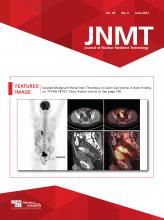Rationale
18F-NaF PET/CT is indicated for diagnostic imaging of bone to define altered osteogenic areas of activity. It provides high-resolution, high-contrast images of the skeletal tissue and has higher sensitivity, specificity, and accuracy than conventional nuclear bone scintigraphy. The low-dose CT component provides accurate anatomic localization of structures within the body and enables differentiation of benign versus malignant boney lesions (1 ⇓–3).
Clinical Indications (4)
• Diagnosis of occult fracture, stress reaction or stress fracture, avascular necrosis, arthritis, bone infarcts, bone graft viability, Paget disease, reflex sympathetic dystrophy, and unexplained bone pain.
• Evaluation of distribution of osteoblastic activity before radionuclide therapy for bone pain.
Contraindications (3,4)
• Pregnancy or breastfeeding. Pregnancy should be excluded following institutional policy. If the patient is breastfeeding, she should be told to pump and discard breast milk for at least 4 h after tracer administration and to limit contact with the infant for 4 h after tracer administration.
• Barium contrast 24–48 h before the 18F-NaF procedure.
Patient Preparation/Education (2,3)
Prearrival
• Tell the patient that food and prescribed medications can be taken before the procedure.
• Tell the patient to ensure adequate hydration before arrival (i.e., by drinking two or more 237-mL [8-oz] glasses of water 1 h before injection).
Arrival in PET/CT Department
• Obtain a focused history of past and current diseases, interventional or surgical procedures, and medications.
• Measure and record the patient’s height and weight.
• Describe the procedure to the patient, including the time to completion, the required position for imaging (supine), and the need to drink plenty of fluids during the wait time (two 237-mL [8-oz] glasses of water) and after the procedure (as much as tolerated by the patient). Please note that theses glasses of water are in addition to the glasses of water consumed by the patient prior to arrival for the procedure.
• Evaluate the patient’s ability to lie still for up to 30 min.
PET/CT Acquisition Parameters (2,3)
The manufacturer’s recommendations for PET and low-dose CT acquisition parameters are shown in Tables 1 and 2.
Standard Parameters for PET Acquisition
Standard Parameters for Low-Dose CT Acquisition
Protocol/Acquisition Instructions (1⇓–3)
• Administer the 18F-NaF intravenously (Table 3, followed by a saline flush.
• Allow a tracer uptake period of 30–45 min (90–120 min when scanning the whole body). There are no physical or eating restrictions during the uptake period. Instruct the patient to drink water and to void frequently.
• Instruct the patient to void immediately before imaging and between image sets, as necessary.
• Position the patient supine on the imaging table with the arms above the head for axial skeleton imaging or at the patient’s side for whole-body imaging.
• Assess the patient’s comfort level. If needed, add wedges under the patient’s knees to alleviate pressure on the back.
• Perform a topogram (scout) CT scan to set the CT and PET region from skull base to mid thigh and to be used for anatomic localization and attenuation correction.
• Begin the PET acquisition immediately after the CT scan.
• Assess the raw images for motion before the patient departs.
• Instruct the departing patient to continue drinking fluids and voiding frequently for the rest of the day.
18F-NaF Administration Recommendations
Image Processing ( 2,3 )
• Keep in mind that the appropriate reconstruction parameters depend on the acquisition mode. Iterative reconstruction is most often used for clinical applications.
• Refer to the manufacturer’s guidelines for reconstruction protocols for emission data that correct for detector efficiency (normalization), system dead time, random coincidences, scatter attenuation, and sampling nonuniformity.
• Create non–attenuation-corrected and attenuation-corrected images.
• Appropriately scale the data and display them in transaxial, coronal, and sagittal planes and as a rotating maximum-intensity-projection image.







